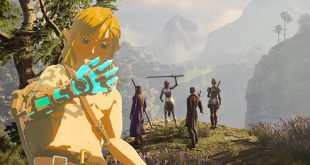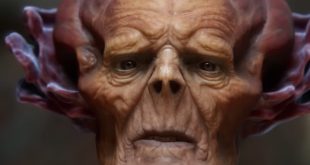For ten years, Dr Eric Risser has been determined to solve a problem. At GDC 2016, he shared his solution with developers around the world.
Having started experimenting with games development as a teenager, Risser soon found he was the type of artist who would spend eight hours making a house – then be disappointed when he realised he had to make a whole village.
Given the growing size of open worlds and the rising expectations for detail, a ‘create, copy, paste’ attitude to building art assets is no longer acceptable to most consumers. But how can artists keep their creativity at a maximum throughout large-scale projects?
Risser’s new service firm Artomatix offers an alternative. The company uses AI software to analyse assets uploaded by artists, then generates similar – but, crucially, unique – assets of its own. The uploads can range from textures to 3D models, and the output will be based entirely on the original work.
“Imagine being tasked with creating 100 unique zombies,” co-founder Neal O’Gorman offers Develop by way of example.
“That’s fun when you create the first three or four. It’s a bit boring by the time you’ve created your hundredth. The same goes for bricks in the wall and that kind of thing.”
He then shows us a screen filled with zombie heads, each one subtly different and all extracted from the original three heads created by the artist. It’s an impressive tool – so why restrict it to an online service, rather than releasing it as a standalone product?
"We’re allowing an artist to get their concept out there without having to spend all their time on the mundane. The creative process is what’s really important."
Neal O’Gorman, Artomatix
“Because we’re running some serious computation here,” O’Gorman says.
“We’re applying artificial intelligence to create new art. All that computation is happening on the cloud, on software servers, using high-end Nvidia GPU cards. So every time someone is generating something, it’s costing us. That’s the legitimate reason for it being a service.
“Some people ask if it can be a downloadable tool. The answer is not really at this stage because you need specific high-end hardware. Otherwise you could be waiting a while for your art to be generated – for some of the technology that we’re bringing out, that just doesn’t make any sense.”
While the array of zombie heads serves as a great introduction to Artomatix, it is by no means the limit of what the technology can do. O’Gorman confidently claims that any type of 3D model could be uploaded and the AI would learn enough from the artist’s creation to generate more.
“We don’t know that what you’re uploading is a head – we don’t identify what it is,” he says. “For some, that’s a drawback, but that’s actually the beauty of it, because it means we can take any input, learn from it, identify a rulebase and try to break a little bit outside of it.”
Sticking with heads, however, O’Gorman shows us another example: dozens of humanoid heads derived from just two – one human, one orc.
“One face gives us a lot of information,” he explains. “A second face gives us a little bit more unique information, but there’s a lot of redundant stuff: there’s still two eyes, a nose, a mouth and so on. A third face adds a little bit more, but as you keep adding new faces, the unique information decreases.
“However, our tech can even learn to the point where it generates heads without earlobes, for example. So it’s not just taking the nose of one and the ear of another – it’s actually able to grow new things.”
Growing new heads is just one milestone on Artomatix’s roadmap. The firm says it has 11 ‘core pieces of technology’ it wants to introduce over time that will solve various different problems for artists. With each addition, the possibilities and the range of artists the firm will be able to help will increase.
“One tool that’s in the works, for example, is something we call ‘Texture Paint’,” says O’Gorman. “As that matures, we’ll reach the point where someone can be literally painting in the texture in 3D, and not just with colour. For that, it needs to be responsive; they need to be able to see their work growing as they’re moving, and that’s going to be really impressive.”
To demonstrate, he shows us an image of the Artomatix logo created out of flowers (opposite). One of the firm’s artists developed a single texture tile, specified the shape of the logo and the software handled the rest.
The company is starting with just a handful of features, the first of which is making textures ‘tileable’.
“It’s our least sexy feature,” O’Gorman admits, “but it’s a perfect example of saving the artist time. Artists are already able to blend textures together, but we spoke with one triple-A studio who said that for their most recent game they did it 3,000 times – it could take from half an hour to two days depending on how detailed the texture is. That’s boring work – you’re not getting the most out of your artists. We can take that texture and make it tileable within a matter of seconds.”
This creates the problem of seams, visible lines that players will be able distinguish as the border between tiles. Artomatix is able to grow the texture over a larger range in a way that covers these seams.
“There’s only so large you can go, particularly on phones, so we have also created what we call ‘Infinity Tiles’,” O’Gorman says.
“These basically allow you to take a texture and create 16 new variants that can sit together in a particular way so that, when you follow the ruleset, you can cover a mountain completely without any repeating pattern. This concept has existed before, but we can automatically create it. It doesn’t just look better, but runs better too.”
"Our tech can even learn to the point where it generates heads without earlobes. It’s not just taking the nose of one and the ear of another – it’s actually able to grow new things."
Neal O’Gorman, Artomatix
Unlike many of the new tools on the market, Artomatix isn’t designed to make life easier for indies and smaller studios. Instead, it is initially targeted at larger and triple-A studios.
“The companies that are going to benefit most from this are those that are creating big open worlds,” says O’Gorman. “Someone who is really under pressure to create an awful lot of art assets, who really needs diversity. They need the quality and we will hit that quality, get that performance right for them, and then it will be in a position to be applicable to the rest of the industry.”
In fact, Artomatix has been working on its software with the help of a large, triple-A studio over the past 12 months. While O’Gorman is unable to divulge which studio, he teases: “Everybody knows their franchise.”
“They’ve been amazed and impressed with our technology, and are actually looking at using this not only for production but also post-production,” he says. “It’s still applicable after a game is released because you can continue uploading new art assets to give your title a new look. That’s something that intrigues them.”
Ultimately, the plan is to make this available to everyone – including indies – although this is likely to have restrictions so smaller studios won’t be able to flood the service with thousands of art assets.
Artomatix is currently in beta and therefore free, with final pricing to be decided, but it is expected to have a three-tier price range: one for indies, one for medium-sized studios and another for triple-As. As each of those 11 pieces of technology are added, O’Gorman is confident the service will provide more value.
“We’re allowing an artist to get their concept out there without having to spend all their time on the mundane,” he says. “The creative process is what’s really important, rather than the tedious elements of actually building it.
“We also open doors to a lot of things people have never been able to do before. A lot of people who see this think it would be great on the conceptual side. Everybody knows that the better a concept looks, the more it sells the concept.
“The whole concept is making sure no two things look the same. It’s all art creation based on the examples. Some people instantly go: ‘Ah, you’re procedural.’We’re not quite, but it’s the closest thing that people can understand because we’re generating art using software. Our starting point is the artist’s input. We want artists to be focused on being creative, and let us deal with the tedious tasks.”

 MCV/DEVELOP News, events, research and jobs from the games industry
MCV/DEVELOP News, events, research and jobs from the games industry



